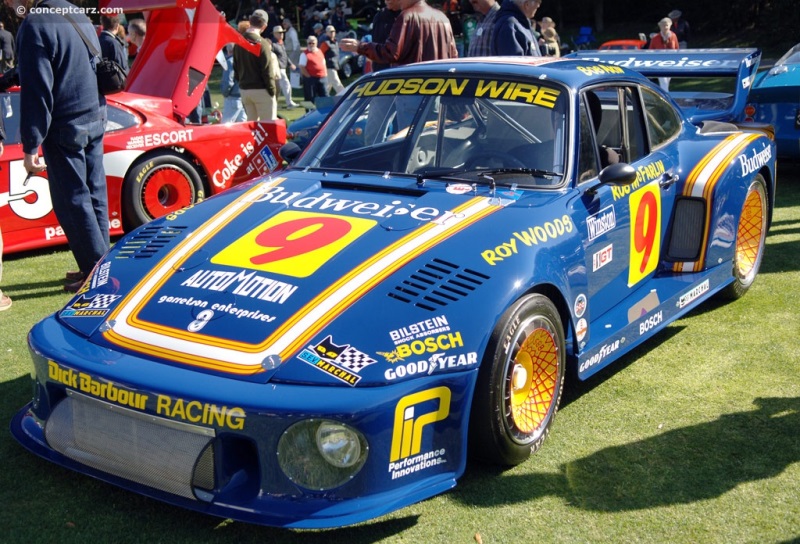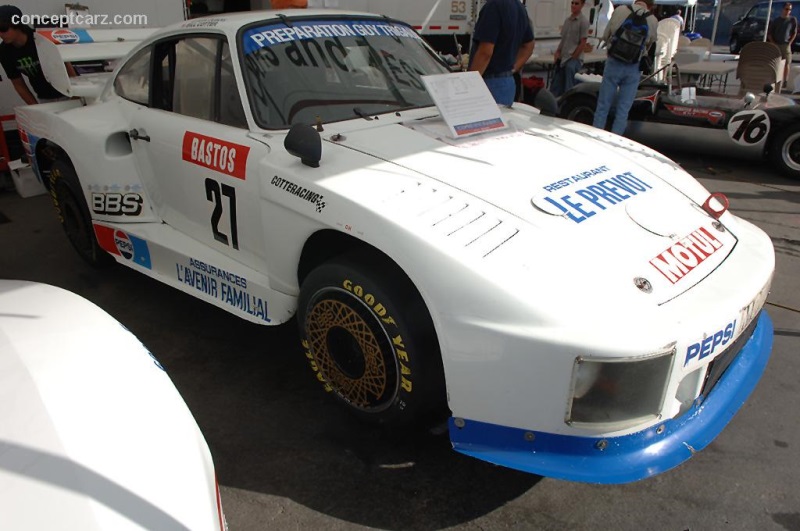The Porsche 935 was the ultimate evolution of the racing 911 and bridged the gap between the 936 prototype and the 956, introduced in 1982. Their existence began when Porsche adapted its 930 Turbo road car into racing guise, as the benefits of turbocharging had been conclusively demonstrated by the all-conquering 917 sports racing cars. The 930 Turbo Porsche, introduced at the September 1973 Frankfurt Motor Show, and its variants including the Turbo Carrera Group 4 competition would take the turbocharging concept to a whole new level. The Turbo Carrera was a production-based GT based on the 930/911 suspension and body structure and developed to conform to FIA Group 4 rules. Its engine had a standard two-liter Porsche 911 crankshaft, dual ignition, and a displacement size of 2,142cc which equaled the three-liter displacement limit when factoring in the 1.4X supercharging. Among the refinements and modifications derived from years of competition experience, the Bosch mechanical injection system was modified to cope with positive induction pressure. The result was 500 brake horsepower and 340 lb/ft of torque, which meant it delivered more torque than the naturally aspirated 4.5-liter flat-twelve engines that powered the previous Porsche 917. 
Coupe
Chassis #: 9307700903
View info and historyThe FIA ran two separate World Championships for 'sportscars' beginning with the 1976 season, with open-cockpit Group 6 cars contesting the new World Championship for Sports Cars, and production-based cars (including Group 5 Special Production Cars) competed in the World Championship for Makes. Porsche's entry for Group 5 competition was the 935. Over the coming seasons, the Porsche 935 would win all the major endurance races including the Nurburging, Daytona, Sebring, Wakins Glen, and LeMans. The 1976 24 Hours of Le Mans was open to both types of cars (Group 5 and 6) and did not count towards either championship. Porsche ultimately won the Championship of Makes. Both the Porsche 935 and its engine would evolve over the years, with the engine later powering the 936 prototypes and eventually the 956 and 962 sports prototypes. The 935 became a full tube-frame racing car design sharing only the mandatory elements with its Porsche 911 and 930 production siblings. To ensure success at all levels of racing and the various circuits, specific variants were built including the long tail 'Moby Dick' which had a low frontal area and perfectly suited for the high-speed Le Mans circuit. What was similar between all 935 variants were their use of the latest technology and design elements, and maximizing every performance benefit allowed within the racing regulations. Among the creative elements employed by Porsche included 19-inch rear wheels which complied with the rules' limit of 16-inch maximum tire width, while lengthening the tires' contact patch and providing grip similar to much wider tires of smaller diameter. Although Porsche was creative, the governing bodies (including IMSA, SCCA, FIA, and CSI) made the process difficult, often with abrupt rule changes that quickly made technology, and at times vehicles, obsolete. Throughout its existence, the 935 would use air-, oil, and water cooling, single and twin-turbocharging, single and dual ignition, two- and four-valves, 2-, 2.2-, 3-, and 3.2-liter displacements, and air-air and air-water intercooling. In its ultimate guise, the 935 flat-six engine offered over 800 brake horsepower, putting on par with the flat-12 engine of the previous Porsche 917. 
Coupe
Chassis #: 930 770 0912
Engine #: 677-2911 & 777 2912
View info and historyWhen Porsche's focus shifted to the development of the 956 and 962 sports prototypes, outside privateers and tuners began building variants of their design. The list includes the racing Kremer brothers, Reinhold Jöst, Bob Akin, and Dick Barbour. 1976 Season
Group 4 and Group 5 rules differed primarily on the modifications allowed to the chassis and body. The Works team priority was focused on Group 5 specification as it counted towards that year's World Championship. Visually (and initially), the 935 was similar to the RSR Turbo and wore a similar nose to the 911, distinguished by a large rear wing and flared wheel arches. The torsion bar suspension was replaced by adjustable anti-roll bars, and cross-drilled discs placed front and rear were aptly suited for the rigors of competition. One of the fundamental keys to racing success is extensive testing and preparation, and during this process, Porsche engineers found that the frontal area, with the protruding headlights, created drag. To resolve this issue, albeit, with controversy, the original nose was replaced with a flat nose with the lights relocated into the bumpers.Porsche had two 935 racers prepared in time for the season-opening race at Mugello, which it won along with the following race at Vallelunga. The stage was set for a successful season but that quickly changed when the 935 was scrutinized by the sport's governing body. The original 930 engine cover did not fit as required by rules due to the large intercooler. Unable to race until the issue was resolved, engineers fitted the intercooler of the 934 onto the 935. Although this fixed one problem, it was less reliable than with the previous intercooler. The reliability was eventually resolved but in the meantime, BMW had scored important victories, putting Porsche's chances of obtaining the World Championship in jeopardy. As the season came to a close, the 935 was once again a dominant machine and was able to secure enough points to earn Porsche the World Championship.
Coupe
Chassis #: 0909For Le Mans, the Porsche 935 was driven by Stommelen and Schurti which they qualified in the third position. Wearing Group 5 silhouette, the car finished fourth overall. The Porsche 936 claimed the overall victory. 1977 Season
While other manufacturers did not supply customer cars, Porsche began offering the 935 to customers entering the World Championship for Makes, in the IMSA GT Championship, and in the German Deutsche Rennsport Meisterschaft (DRM). This greatly increased the factory's chances of defending its title as each race typically featured at least five 935s. The downside to this approach meant that the factory had to focus on building customer cars and developing improvements for the Works cars. Numerous changes were made to the factory cars in preparation for the 1977 season, with the biggest improvements focusing on the engine. Changes were made to the aerodynamics and suspension, but it was the replacement of the single large turbocharger with the two smaller KKK units that offered the most profound performance improvements, with horsepower increasing to approximately 630 bhp (eventually to around 680 bhp by the close of the season) and the reduction of Turbo lag. The Works team and their two 935s were very successful throughout the season, earning many Group 5 class victories and another World Championship. A works 935/77 was brought to Le Mans but were unable to finish the race due to a blown engine. A customer 935 (JMS Racing / ASA Cachia) finished third overall and the Martini Racing Porsche 936/77 driven by Jürgen Barth, Hurley Haywood, and Jacky Ickx finished first overall.
Coupe
Chassis #: 0910
View info and historyPorsche sold thirteen examples of the 935/77A to privateer teams in the United States, Germany, Italy, France, and Australia. The customer 935/77A won four of the nine World Championship for Makes events, and many of these customers were not happy when Porsche raced with a newer version of the 935. The factory, however, continued to develop and race the car to keep it competitive against other manufacturers including BMW. Additional modified customer cars were sold by Porsche in 1978 and 1979. The 935 remained highly competitive until rule changes in 1982 brought its racing career to an end. Of the 370 races it contested, it emerged victorious 123 times.
by Daniel Vaughan | Jun 2021
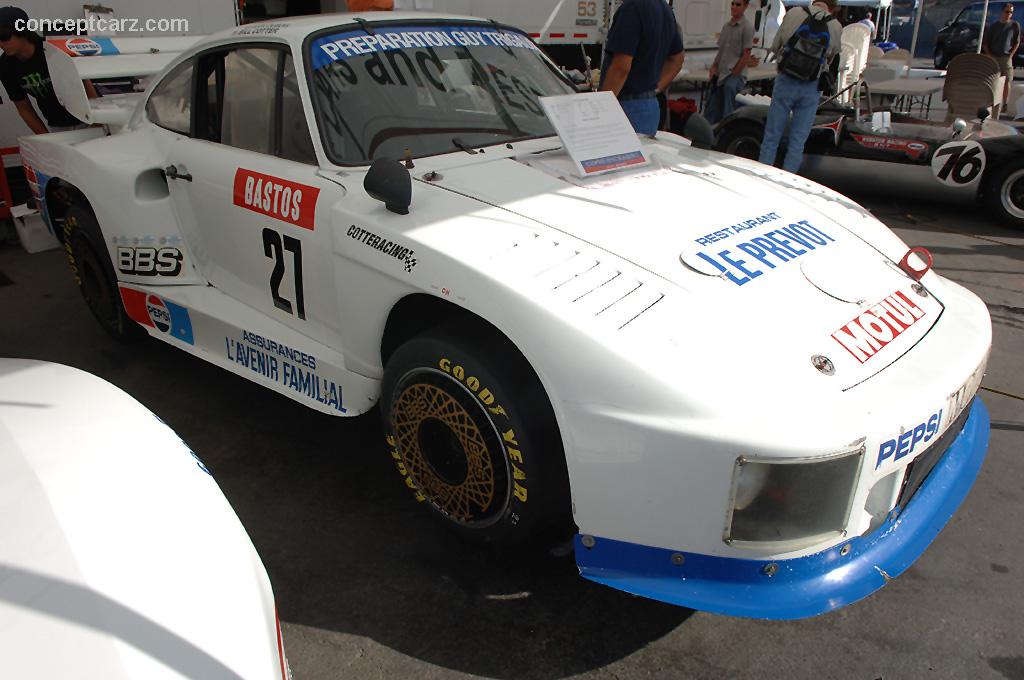
Coupe
Chassis #: 9307700903
View info and history
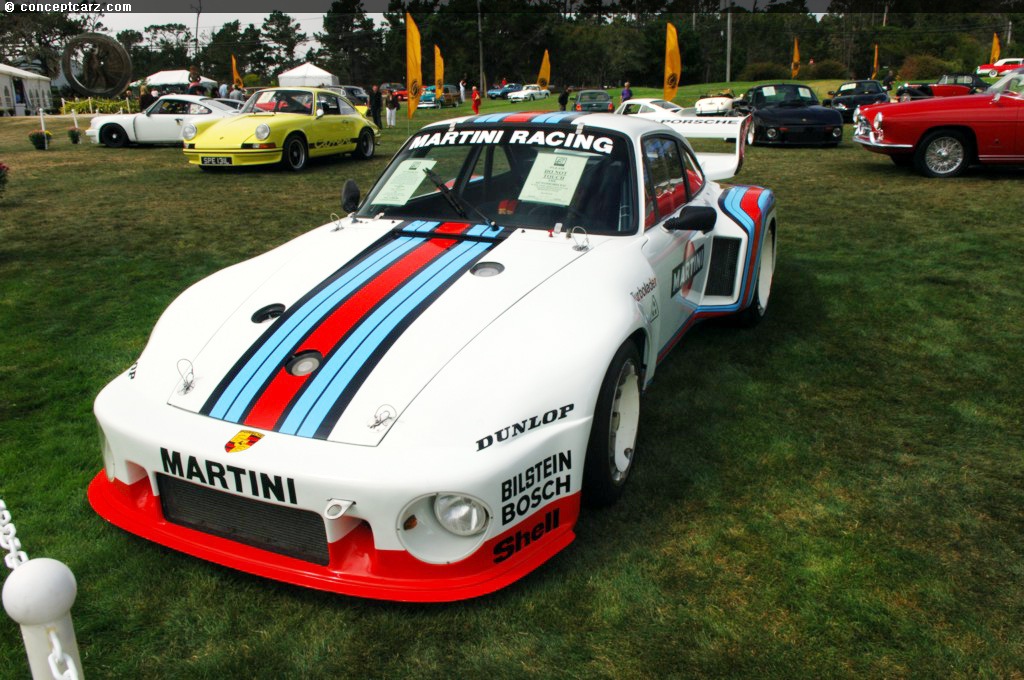
Coupe
Chassis #: 930 770 0912
Engine #: 677-2911 & 777 2912
View info and history
Group 4 and Group 5 rules differed primarily on the modifications allowed to the chassis and body. The Works team priority was focused on Group 5 specification as it counted towards that year's World Championship. Visually (and initially), the 935 was similar to the RSR Turbo and wore a similar nose to the 911, distinguished by a large rear wing and flared wheel arches. The torsion bar suspension was replaced by adjustable anti-roll bars, and cross-drilled discs placed front and rear were aptly suited for the rigors of competition. One of the fundamental keys to racing success is extensive testing and preparation, and during this process, Porsche engineers found that the frontal area, with the protruding headlights, created drag. To resolve this issue, albeit, with controversy, the original nose was replaced with a flat nose with the lights relocated into the bumpers.Porsche had two 935 racers prepared in time for the season-opening race at Mugello, which it won along with the following race at Vallelunga. The stage was set for a successful season but that quickly changed when the 935 was scrutinized by the sport's governing body. The original 930 engine cover did not fit as required by rules due to the large intercooler. Unable to race until the issue was resolved, engineers fitted the intercooler of the 934 onto the 935. Although this fixed one problem, it was less reliable than with the previous intercooler. The reliability was eventually resolved but in the meantime, BMW had scored important victories, putting Porsche's chances of obtaining the World Championship in jeopardy. As the season came to a close, the 935 was once again a dominant machine and was able to secure enough points to earn Porsche the World Championship.
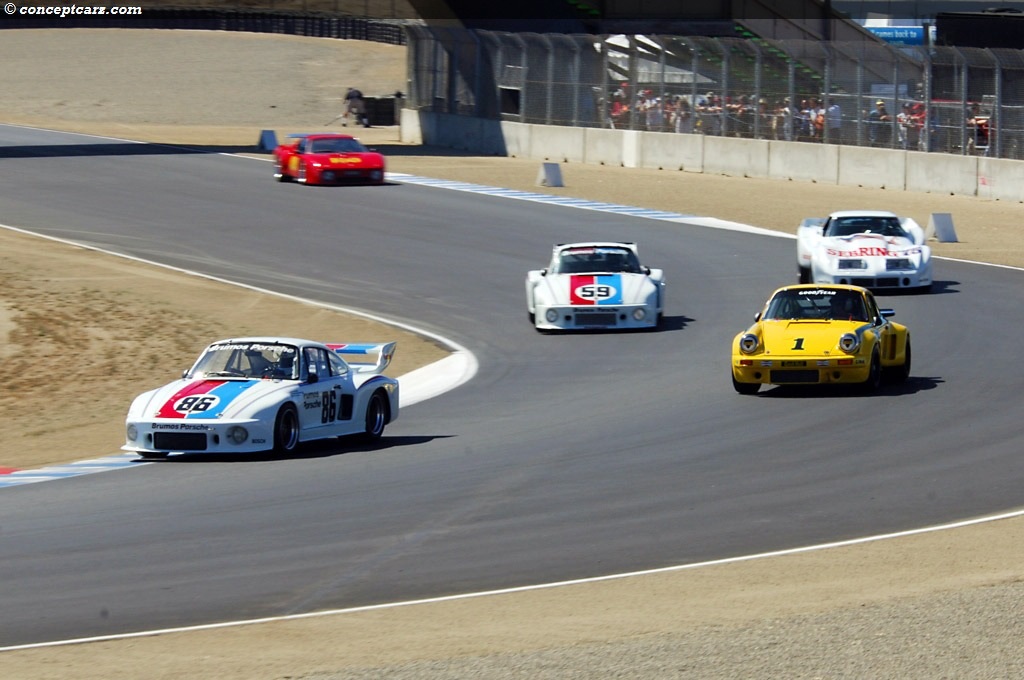
Coupe
Chassis #: 0909
While other manufacturers did not supply customer cars, Porsche began offering the 935 to customers entering the World Championship for Makes, in the IMSA GT Championship, and in the German Deutsche Rennsport Meisterschaft (DRM). This greatly increased the factory's chances of defending its title as each race typically featured at least five 935s. The downside to this approach meant that the factory had to focus on building customer cars and developing improvements for the Works cars. Numerous changes were made to the factory cars in preparation for the 1977 season, with the biggest improvements focusing on the engine. Changes were made to the aerodynamics and suspension, but it was the replacement of the single large turbocharger with the two smaller KKK units that offered the most profound performance improvements, with horsepower increasing to approximately 630 bhp (eventually to around 680 bhp by the close of the season) and the reduction of Turbo lag. The Works team and their two 935s were very successful throughout the season, earning many Group 5 class victories and another World Championship. A works 935/77 was brought to Le Mans but were unable to finish the race due to a blown engine. A customer 935 (JMS Racing / ASA Cachia) finished third overall and the Martini Racing Porsche 936/77 driven by Jürgen Barth, Hurley Haywood, and Jacky Ickx finished first overall.
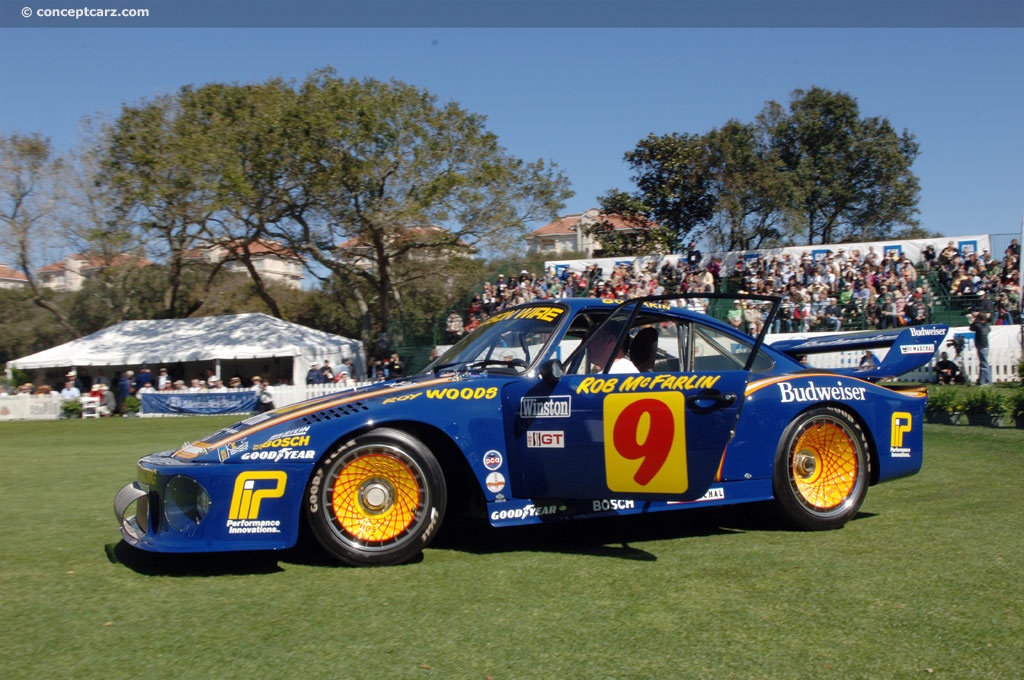
Coupe
Chassis #: 0910
View info and history
by Daniel Vaughan | Jun 2021
Related Reading : Porsche 934/935 History
In 1976, Porsche introduced a racing version of the Porsche 930911 Turbo which they dubbed, the 935. It was designed for FIA-Group 5 competition and was constructed in a similar fashion to the Porsche 934, which was used in Group 4 competition. The works team, with sponsorship by Martini, entered the 935 in the FIA World Championship for Makes with team drivers, Jacky Ickx and Jochen Mass in....
Continue Reading >>
Continue Reading >>
1977 Porsche 935 Vehicle Profiles
Recent Vehicle Additions
Related Automotive News

Porsche Rennsport Reunion VI : Highlights: of man and machines
Stuttgart. The Porsche Rennsport Reunion VI at Laguna Seca (USA) has more than 60,000 fans of the brand from Stuttgart spellbound. At the four-day event in California, avid motor racing enthusiasts in legendary vehicles and unforgotten works...

BILL WARNER IS RRDC'S 2014 BOB AKIN AWARD WINNER
DAYTONA BEACH, Fla. (Jan. 22, 2015) - Bill Warner, best known as the force behind the hugely successful Amelia Island Concours dElegance since 1996, received the 2014 Bob Akin Award from the Road Racing Drivers Club at a dinner prior to the running...

PORSCHE MOTORSPORTS PRE-EVENT NOTES. 24 HOURS OF LE MANS
The #20 Porsche 919 Hybrid with drivers (left to right) Mark Webber, Timo Bernhard, and Brendon Hartley, at Le Mans tech inspection earlier today in the town of Le Mans.
Dateline. Le Mans, France
Circuit. Circuit de la Sarthe
Track LengthTurns....
RRDC VOTES IN 37 NEW MEMBERS FOR 2013
HILLIARD, Ohio (Nov. 7, 2013) - Thirty-seven race-car drivers and motorsports professionals have been voted into the Road Racing Drivers Club in 2013. The group includes 13 Regular Members from the open-wheel and sports-car racing ranks, 20 Associate...

EXCEPTIONAL ROSTER OF PORSCHE RACE CARS JOIN THE STARTING GRID FOR RM'S EAGERLY AWAITED MONTEREY SALE
RM Auctions, the worlds largest collector car auction house for investment-quality automobiles, has announced more star consignments for its highly anticipated Monterey sale, August 17–18, in California, this time a remarkable group of Porsches. Comprising...






















